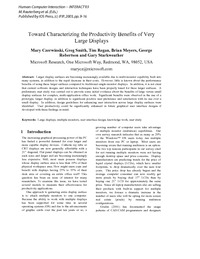Toward Characterizing the Productivity Benefits of Very Large DisplaysErstpublikation in: Human-Computer Interaction -- INTERACT'03
Publikationsdatum:
|
 |
 Diese Seite wurde seit 4 Jahren inhaltlich nicht mehr aktualisiert.
Unter Umständen ist sie nicht mehr aktuell.
Diese Seite wurde seit 4 Jahren inhaltlich nicht mehr aktualisiert.
Unter Umständen ist sie nicht mehr aktuell.
 Zusammenfassungen
Zusammenfassungen
This study demonstrated that there is a significant
performance advantage to using very large, multiple
monitor display surfaces while carrying out complex,
cognitively loaded productivity tasks on the
computer.
Von M. Czerwinski, Greg Smith, Tim Regan, Brian Meyers, George Robertson, Gary Starkweather im Text Toward Characterizing the Productivity Benefits of Very Large Displays (2003) Larger display surfaces are becoming increasingly available due to multi-monitor capability built into
many systems, in addition to the rapid decrease in their costs. However, little is known about the performance
benefits of using these larger surfaces compared to traditional single-monitor displays. In addition, it is not clear
that current software designs and interaction techniques have been properly tuned for these larger surfaces. A
preliminary user study was carried out to provide some initial evidence about the benefits of large versus small
display surfaces for complex, multi-application office work. Significant benefits were observed in the use of a
prototype, larger display, in addition to significant positive user preference and satisfaction with its use over a
small display. In addition, design guidelines for enhancing user interaction across large display surfaces were
identified. User productivity could be significantly enhanced in future graphical user interface designs if
developed with these findings in mind.
Von M. Czerwinski, Greg Smith, Tim Regan, Brian Meyers, George Robertson, Gary Starkweather im Text Toward Characterizing the Productivity Benefits of Very Large Displays (2003) auf Seite 1 Dieser Text erwähnt ...
Dieser Text erwähnt ...
 Tagcloud
Tagcloud
 Zitationsgraph
Zitationsgraph
 Zitationsgraph (Beta-Test mit vis.js)
Zitationsgraph (Beta-Test mit vis.js)
 3 Erwähnungen
3 Erwähnungen 
- Effects of tiled high-resolution display on basic visualization and navigation tasks (Robert Ball, Chris North) (2005)


- The Large-Display User Experience (George Robertson, M. Czerwinski, Patrick Baudisch, Brian Meyers, Daniel C. Robbins, Greg Smith, Desney Tan) (2005)


- Shaping the Display of the Future - The Effects of Display Size and Curvature on User Performance and Insights (Lauren Shupp, Christopher Andrews, Margaret Kurdziolek, Beth Yost, Chris North) (2008)


 Volltext dieses Dokuments
Volltext dieses Dokuments
 |  Toward Characterizing the Productivity Benefits of Very Large Displays: Artikel als Volltext ( Toward Characterizing the Productivity Benefits of Very Large Displays: Artikel als Volltext ( : :  , 329 kByte; , 329 kByte;  : :  Link unterbrochen? Letzte Überprüfung: 2020-11-28 Letzte erfolgreiche Überprüfung: 2020-06-28) Link unterbrochen? Letzte Überprüfung: 2020-11-28 Letzte erfolgreiche Überprüfung: 2020-06-28) |
 Anderswo suchen
Anderswo suchen 
 Beat und dieser Text
Beat und dieser Text
Beat hat Dieser Text während seiner Zeit am Institut für Medien und Schule (IMS) ins Biblionetz aufgenommen. Beat besitzt kein physisches, aber ein digitales Exemplar. Eine digitale Version ist auf dem Internet verfügbar (s.o.). Aufgrund der wenigen Einträge im Biblionetz scheint er es nicht wirklich gelesen zu haben. Es gibt bisher auch nur wenige Objekte im Biblionetz, die dieses Werk zitieren.









 GUI (Graphical User Interface)
GUI (Graphical User Interface) Software
Software User Interface (Benutzerschnittstelle)
User Interface (Benutzerschnittstelle) Biblionetz-History
Biblionetz-History